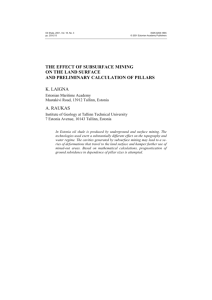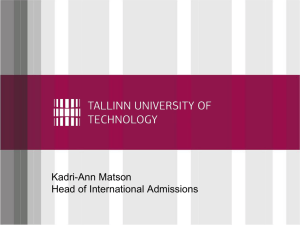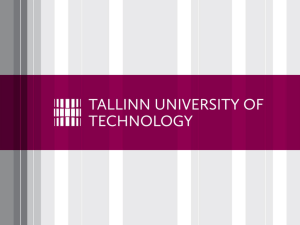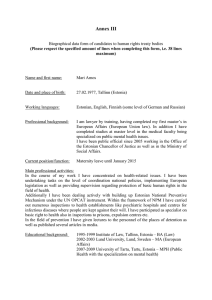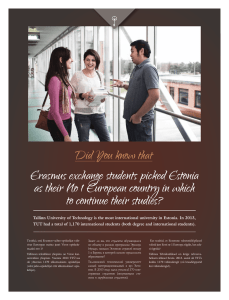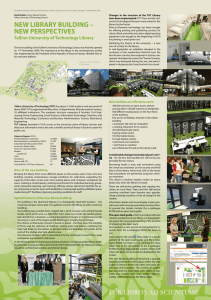Estonia - DAC.com
advertisement
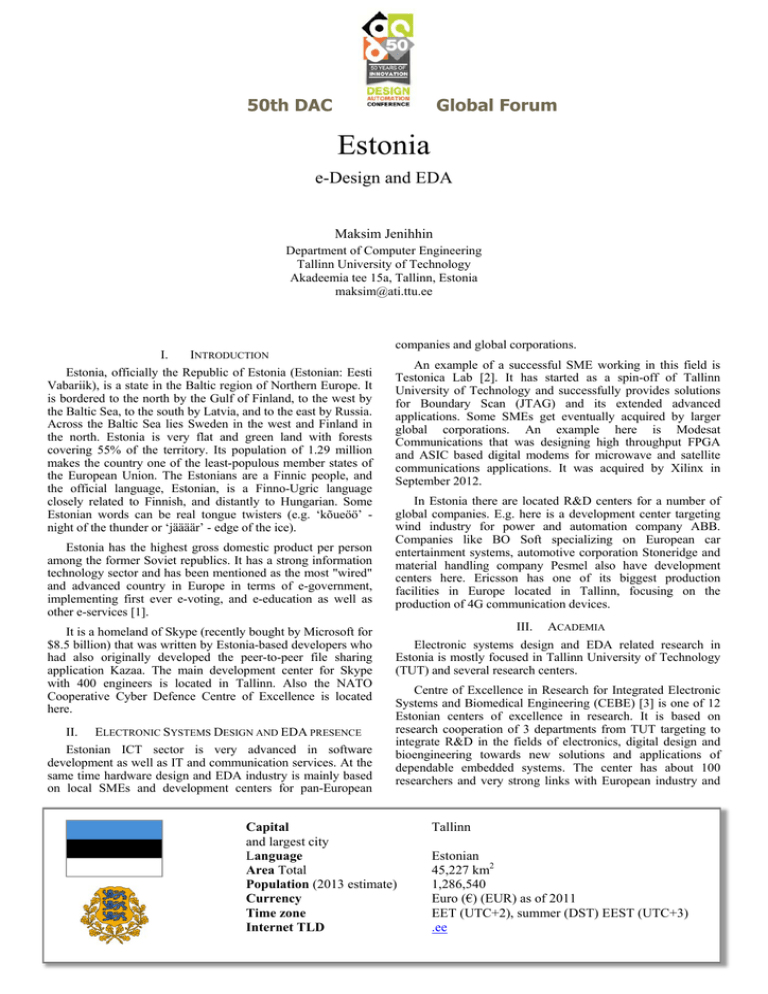
50th DAC Global Forum Estonia e-Design and EDA Maksim Jenihhin Department of Computer Engineering Tallinn University of Technology Akadeemia tee 15a, Tallinn, Estonia maksim@ati.ttu.ee I. INTRODUCTION Estonia, officially the Republic of Estonia (Estonian: Eesti Vabariik), is a state in the Baltic region of Northern Europe. It is bordered to the north by the Gulf of Finland, to the west by the Baltic Sea, to the south by Latvia, and to the east by Russia. Across the Baltic Sea lies Sweden in the west and Finland in the north. Estonia is very flat and green land with forests covering 55% of the territory. Its population of 1.29 million makes the country one of the least-populous member states of the European Union. The Estonians are a Finnic people, and the official language, Estonian, is a Finno-Ugric language closely related to Finnish, and distantly to Hungarian. Some Estonian words can be real tongue twisters (e.g. ‘kõueöö’ night of the thunder or ‘jäääär’ - edge of the ice). Estonia has the highest gross domestic product per person among the former Soviet republics. It has a strong information technology sector and has been mentioned as the most "wired" and advanced country in Europe in terms of e-government, implementing first ever e-voting, and e-education as well as other e-services [1]. It is a homeland of Skype (recently bought by Microsoft for $8.5 billion) that was written by Estonia-based developers who had also originally developed the peer-to-peer file sharing application Kazaa. The main development center for Skype with 400 engineers is located in Tallinn. Also the NATO Cooperative Cyber Defence Centre of Excellence is located here. II. ELECTRONIC SYSTEMS DESIGN AND EDA PRESENCE Estonian ICT sector is very advanced in software development as well as IT and communication services. At the same time hardware design and EDA industry is mainly based on local SMEs and development centers for pan-European companies and global corporations. An example of a successful SME working in this field is Testonica Lab [2]. It has started as a spin-off of Tallinn University of Technology and successfully provides solutions for Boundary Scan (JTAG) and its extended advanced applications. Some SMEs get eventually acquired by larger global corporations. An example here is Modesat Communications that was designing high throughput FPGA and ASIC based digital modems for microwave and satellite communications applications. It was acquired by Xilinx in September 2012. In Estonia there are located R&D centers for a number of global companies. E.g. here is a development center targeting wind industry for power and automation company ABB. Companies like BO Soft specializing on European car entertainment systems, automotive corporation Stoneridge and material handling company Pesmel also have development centers here. Ericsson has one of its biggest production facilities in Europe located in Tallinn, focusing on the production of 4G communication devices. III. ACADEMIA Electronic systems design and EDA related research in Estonia is mostly focused in Tallinn University of Technology (TUT) and several research centers. Centre of Excellence in Research for Integrated Electronic Systems and Biomedical Engineering (CEBE) [3] is one of 12 Estonian centers of excellence in research. It is based on research cooperation of 3 departments from TUT targeting to integrate R&D in the fields of electronics, digital design and bioengineering towards new solutions and applications of dependable embedded systems. The center has about 100 researchers and very strong links with European industry and Capital and largest city Language Area Total Population (2013 estimate) Currency Time zone Internet TLD Tallinn Estonian 45,227 km2 1,286,540 Euro (€) (EUR) as of 2011 EET (UTC+2), summer (DST) EEST (UTC+3) .ee 50th DAC healthcare sectors. Recent achievements of the center include patents and implementations for health monitoring systems such as brain signal analysis for human depression detection, implantable cardiac pacemakers, bio-impedance and optical signal analyzers. Tallinn University of Technology and the Department of Computer Engineering specifically is the place where the main electronic systems design and EDA research activity takes place. The university has approximately 14K students and it is the only technical university in Estonia. The main research directions of the department are design of multi- and many-core systems, verification and debug, manufacturing chip and board test, diagnostic modeling of digital systems and digital hardware synthesis. TUT prof. Raimund Ubar was one of the pioneers in the binary decision diagrams research, by starting to apply them for test pattern generation and publishing first results in 1976. Since then design representation by decision diagrams was playing a significant role in the design, test and EDA related research directions. The competence includes models, methodologies and frameworks for levels of abstraction ranging from gate to register-transfer and higher that are based on structurally synthesized binary decision diagrams (SSBDD) and high-level decision diagrams (HLDD). TUT takes part in development of an open-source framework zamiaCAD [4] for hardware design and debug. The framework makes emphasis on scalability and supports very large industrial scale RTL designs. International cooperation is crucial for a small country and Estonia was very successful in establishing productive synergy with partners in Europe and worldwide. Historically after the collapse of the Soviet Union and the followed crisis in 1990s, European countries, with Germany and France in the first place, became partners in bilateral cooperation. Further the network has grown covering many active groups worldwide. In recent years TUT participated in more than 15 large European research projects including European Commission research projects FP6-IST VERTIGO: Verification and Validation of Embedded Systems Design Workbench and FP7-IST DIAMOND - Diagnosis, Error Modelling and Correction for Reliable Systems Design [5] involving IBM and Ericsson. The last one was initiated and coordinated by TUT (prof. Jaan Raik). As a part of the design and EDA community Estonia has hosted a number of scientific conferences in the area including ETS in 2005, NORCHIP in 2008, DDECS in 2012 and will organize HiPEAC Computing Systems Week in 2013. IEEE Baltic Electronics Conference is organized by TUT biennially since 1988. Recent initiative by TUT and Brazilian PUCRS Global Forum university has led to the birth of the Biannual European - Latin American Summer School on Design, Test and Reliability BELAS kicking-off with the first event in Tallinn in 2013. IV. GOVERNMENT PROGRAMS Being a member of the European Union since 2004, Estonia is an active partner in the EU development programs targeted at micro- and nanoelectronics industry and research support. Estonian institutions take advantage of the EU framework programs and related initiatives by participating and coordinating projects together with other European countries. National mechanisms for industry and academy support include Estonian Research Council and Estonian Information Technology Foundation managing national funds, Archimedes Foundation managing funds from EU as well as Enterprise Estonia responsible for industry support and knowledge transfer from academy to industry. The latter one has for example established the Competence Centre in Electronics, Info- and Communication Technologies (ELIKO). The center develops innovative technologies and products, based on intelligent embedded systems, through strategic cooperation between the science and industry sectors. V. EDUCATION In Estonia it is possible to get higher education in the electronic systems design and EDA field in TUT, University of Tartu (established in 1632) which is the largest university in the country but has a more general focus, and finally IT College being a private institution. Targeting the need of highly qualified personnel for ICT sector a cooperation program between the state, companies and universities named IT Academy was recently established. The initiative is mainly supported by the private sector with Skype as one of the key sponsors. Particular aims of the program are doubling the number of ICT students and definitive internationalization of the higher education in this area. REFERENCES [1] [2] [3] [4] [5] e-Estonia website - http://e-estonia.com/ Testoniaca Lab website - http://www.testonica.com Centre for Integrated Electronic Systems and Biomedical Engineering – CEBE website - http://cebe.ttu.ee/ zamiaCAD - Open-source framework for hardware design and debug website - http://zamiacad.sf.net/ EC project FP7-IST DIAMOND - Diagnosis, Error Modelling and Correction for Reliable Systems Design website - http://fp7-diamond.eu/ Dr. Maksim Jenihhin is a senior research fellow at the Department of Computer Engineering of Tallinn University of Technology, PhD degree in 2008. His primary research interests include HW functional verification and debug as well as manufacturing testing topics and EDA methodologies. He has co-authored 65 journal and conference papers. Dr. Jenihhin received the IBM Faculty Award 2011/2012. He is the MC member of the EU COST Action IC1103, supervises 4 PhD students and coordinates a sub-project in the excellence center CEBE. He acts as a steering committee co-chair for the BELAS summer school, PC member for IEEE DDECS, NORCHIP, LATW and BEC conferences as well as reviewer for MICPRO, JETTA journals and has served as the organization chair for IEEE DDECS 2012 and several summer schools.
